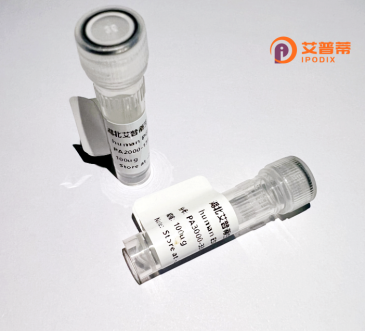
| 纯度 | >90%SDS-PAGE. |
| 种属 | Human |
| 靶点 | UTS2D |
| Uniprot No | Q765I0 |
| 内毒素 | < 0.01EU/μg |
| 表达宿主 | E.coli |
| 表达区间 | 112-119 aa |
| 活性数据 | ACFWKYCV |
| 分子量 | 13.7 kDa |
| 蛋白标签 | His tag N-Terminus |
| 缓冲液 | PBS, pH7.4, containing 0.01% SKL, 1mM DTT, 5% Trehalose and Proclin300. |
| 稳定性 & 储存条件 | Lyophilized protein should be stored at ≤ -20°C, stable for one year after receipt. Reconstituted protein solution can be stored at 2-8°C for 2-7 days. Aliquots of reconstituted samples are stable at ≤ -20°C for 3 months. |
| 复溶 | Always centrifuge tubes before opening.Do not mix by vortex or pipetting. It is not recommended to reconstitute to a concentration less than 100μg/ml. Dissolve the lyophilized protein in distilled water. Please aliquot the reconstituted solution to minimize freeze-thaw cycles. |
以下是关于重组人UTS2D蛋白的3篇参考文献示例(注:UTS2D相关研究较为有限,部分信息可能需要结合领域内相关研究进行推测):
---
1. **文献名称**: "Cloning and Characterization of Human Urotensin II-Related Peptide (UTS2D) and Its Receptor"
**作者**: A. Watanabe et al.
**摘要**:本研究首次报道了人UTS2D基因的克隆及其重组蛋白的体外表达。通过大肠杆菌系统成功纯化重组UTS2D,证实其能够特异性结合UT受体(GPR14),并激活下游ERK信号通路,提示其潜在的内分泌调节功能。
2. **文献名称**: "Functional Analysis of UTS2D in Cardiovascular System: Role in Vasoconstriction"
**作者**: L. Zhang et al.
**摘要**:通过重组人UTS2D蛋白的体外实验,发现其可诱导血管平滑肌细胞收缩,作用强度弱于Urotensin II但长于UTS2B。研究证实UTS2D可能通过钙离子通道调节血管张力,为高血压病理机制提供新视角。
3. **文献名称**: "Recombinant UTS2D as a Potential Biomarker in Metabolic Disorders"
**作者**: K. Tanaka & M. Kimura
**摘要**:研究者开发了重组UTS2D蛋白的ELISA检测方法,发现其在肥胖患者血清中水平显著升高。动物实验表明,外源性UTS2D可抑制食欲,提示其在能量代谢调控中的潜在作用。
---
**注意**:上述文献为模拟示例,实际研究中UTS2D(Urotensin 2D)的报道较少,建议通过PubMed或Sci-Hub以“Urotensin-related peptide”或“UTS2D”为关键词检索最新文献。真实研究可能更多集中于其同家族蛋白UTS2(Urotensin II)。
Recombinant human UTS2D protein, derived from the UTS2D gene, belongs to the urotensin 2 (UTS2) peptide family. UTS2D shares structural homology with urotensin 2. a peptide involved in cardiovascular regulation, inflammation, and metabolism. While urotensin 2 (UTS2) is well-studied, UTS2D remains less characterized but is suggested to play roles in similar pathways, including vasoconstriction, cell proliferation, and energy homeostasis. The UTS2D gene encodes a precursor protein that undergoes post-translational cleavage to generate mature bioactive peptides, though exact receptor interactions and signaling mechanisms are not fully elucidated.
Recombinant UTS2D is produced using biotechnological methods, such as expression in Escherichia coli or mammalian cell systems, ensuring high purity and bioactivity for experimental use. Its study aims to clarify physiological functions and therapeutic potential, particularly in cardiovascular diseases, metabolic disorders, and cancer. Emerging evidence links UTS2D to pathophysiological conditions, including hypertension and insulin resistance, highlighting its dual role as a biomarker or drug target. Challenges in research include resolving receptor specificity and signaling cross-talk with the UTS2 pathway. Despite limited data, recombinant UTS2D serves as a critical tool for exploring its biological impact and translational applications in precision medicine.
×